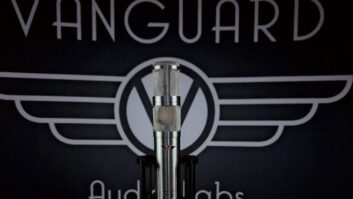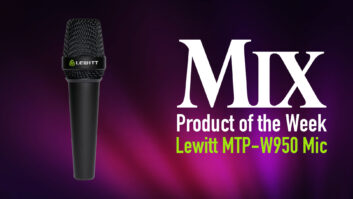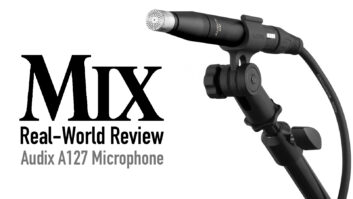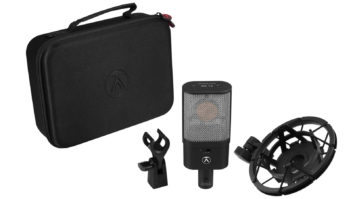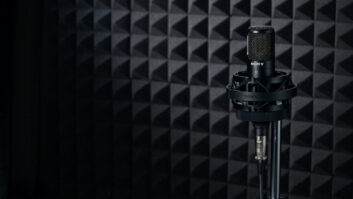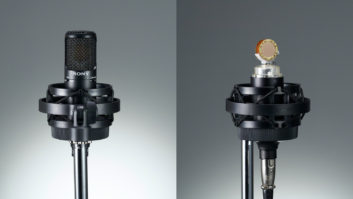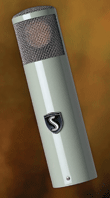
Rethinking classic tube microphone design, Soundelux Microphones’ cardioid-only e250 condenser mic solves the intrinsic problems encountered when close-miking vocalists with large-diaphragm condensers.
Classic tube condenser microphones were not designed to be used six inches or closer to loud singers. But producers and engineers found that they could get a desirable presence, size and low-frequency buildup by having singers move in closer. Close-miking invites pops, sibilant and harsh consonants or peak overloading of the capsule/head amp. Of course, this seems to always happen during the best performances, necessitating retakes and compromising mic placement and sound quality. The e250 addresses these problems, delivering a more controlled outcome while letting the user maintain traditional miking techniques.
WHAT MAKES IT TICK?
A more affordable and mellow version of the company’s ELUX 251, the e250 is not as bright and has a sculpted proximity effect moved up toward the middle of the vocal range rather than more typically below it. Another problem encountered with close-miking vocals is high-frequency directionality, in which any slight head movement by the singer can produce dramatic changes in the high-frequency content. To counteract this, the e250 has a broader cardioid polar pattern than the 251 — a fairly directional mic when used up close.
The “free-center membrane” (i.e., edge-connected) capsules are handpicked and individually tested. They are 1 inch in diameter with a 6-micron-thick, gold-vapor — deposited diaphragm and, like the 251, are mounted in a brass holder. Edge-connected capsules have a longer life span as compared to center-terminated types, in which the edge insulation doesn’t last under moisture and dirt buildup caused by close-miked vocals.
The e250 retains the familiar ELUX 251 color scheme and uses a one-piece electroless, nickel-plated brass body with welded windscreen. The windscreen comprises three mesh layers for maximum plosive protection: a medium first layer like the 251, a smaller second layer and then a very fine inner-mesh layer. The e250 also uses Soundelux’s Stable Bias circuit design that keeps the bias constant on the EF732 tube, regardless of plosives. A different output transformer than the 251 is used with a roll-off starting at 30 Hz rather than 8 Hz, like the 251’s. Delivered in a wood box, the e250 kit comes with a custom shock-mount, ELUX 251’s reliable P251 power supply and all cables.
IN THE STUDIO
Some care is required when setting up the e250 as all of the cables must be plugged in before turning on the power supply. The same 6-pin DIN connectors are used as the ELUX 251 for idiot-proof hookup. The shock-mount basket has two thumbscrews that must be fully backed out before sliding in the mic body, as the thick Soundelux logo emblem must pass through and clear each thumbscrew clamp.
After tightening everything down, I set up a Neumann M149 and the e250 side-by-side and had a male vocalist sing a couple of lead vocal passes into each separately, about four inches away straight into the capsules. I used two channels of a PreSonus M80 mic preamp, and no pop screens, EQ or compression. With the Pro Tools|HD4 Accel system set to 24-bit/88.2 kHz, the M149 only required about 15 dB of gain, while the e250 required about 30 dB for +18dB peaks. The e250 “popped” a lot less than the M149, but both needed pop filters anyway. The e250’s shifted proximity caused a much thicker lower midrange that greatly enhanced my singer’s sound — better than any EQ and/or compressor. The e250’s smoother upper midrange seemed very natural-sounding, while the M149 sounded a little harsh and harder in those frequencies. I got a very impressive and big vocal sound using the e250, but I could tell that I might have to add more upper midrange EQ during the mix — an option that I prefer. I didn’t notice any distortion, “S” problems or high-frequency loss with slight head movement with the e250.
For my “one-mic drum sound” test, I placed both mics four feet out front of my small Ludwig kit and both sounded very good. I liked the e250 for its better spectral balance: the right amount of midrange cut, warmth and bass as compared to the M149. It’s hard to compare these two world-class mics and the two made a very cool “stereo” pair for my anti-pop music drum loop recording.
At another studio and using an Aphex 1100MkII mic pre [also reviewed in this issue — Eds.], the differences were even more dramatic. I recorded an acoustic guitar with the e250 alongside a very old Telefunken U67. The U67 was dark and muddy-sounding, while the e250 had a much clearer and present sound with slight top-end sheen. The e250 had more output level and a wider pickup pattern; I could tell little difference when moving it in and around the sound hole.
THE FINDING?
David Bock, engineer and co-founder of Soundelux Microphones, has produced a worthy variant of his ELUX 251. The e250 amazed me with its huge and impressive sound on everything recorded with it and is well worth the $3,000 investment.
Soundelux (www.soundeluxmics.com), dist. in the U.S. by TransAudio Group, 702/365-5155, www.transaudiogroup.com.

